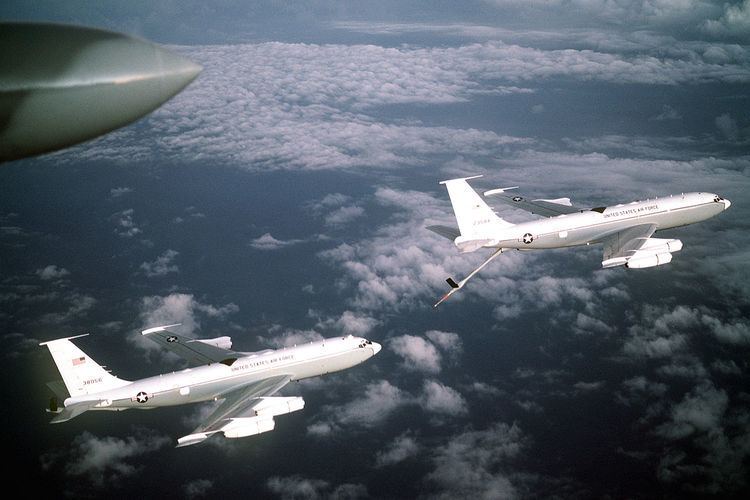The United States Air Force's 2d Airborne Command and Control Squadron was an airborne command and control unit located at Offutt Air Force Base, Nebraska. The squadron was an integral part of the United States' Post Attack Command and Control System, performing the Operation Looking Glass mission with the Boeing EC-135 aircraft.
From its activation in April 1942 until it was disbanded in 1944, the 2d Ferrying Squadron received aircraft at their factory of origin and ferried them to the units to which they were assigned.
The 2d Liaison Squadron provided emergency air evacuation, search and rescue, courier and messenger service, routine reconnaissance and transportation of personnel. It regularly operated between Langley Air Force Base, Virginia and Fort John Custis with one Beechcraft C-45 Expeditor and several Stinson L-13s.
In July 1952, the squadron closed at Langley and reopened at Shaw Air Force Base, South Carolina, operating de Haviland Canada L-20 Beavers. It operated a regular courier service to Pope Air Force Base, North Carolina and Myrtle Beach Air Force Base, South Carolina. In 1953, the squadron also began operating Sikorsky H-19 helicopters. The unit was inactivated in June 1954.
Airborne command post
The 2d Airborne Command and Control Squadron was activated in 1950 to operate Strategic Air Command's (SAC) airborne command post, using Boeing EC-135 aircraft in Operation Looking Glass. The squadron flew three eight hour missions daily, keeping an aircraft with a general officer supporting the Post Attack Command and Control System. This system enabled SAC to control its forces through hostilities even if SAC headquarters had been destroyed. With the end of the Cold War, the squadron was inactivated in 1994.
2d Ferrying SquadronConstituted as the 2d Air Corps Ferrying Squadron on 18 February 1942Activated on 16 April 1942
Redesignated 2d Ferrying Squadron on 12 May 1943Disbanded on 31 March 1944Reconstituted and consolidated with 2d Liaison Squadron and 2d Airborne Command and Control Squadron as the 2d Airborne Command and Control Squadron on 19 September 19852d Liaison SquadronConstituted as the 2d Liaison Flight on 27 September 1949Activated on 25 October 1949
Redesignated 2d Liaison Squadron on 15 July 1952Inactivated on 22 July 1952Activated on 22 July 1952Inactivated on 18 June 1954
Consolidated with 2d Ferrying Squadron and 2d Airborne Command and Control Squadron as the 2d Airborne Command and Control Squadron on 19 September 19852d Airborne Command and Control SquadronConstituted as the 2d Airborne Command and Control Squadron on 12 March 1970Activated on 1 April 1970
Consolidated with 2d Ferrying Squadron and 2d Liaison Squadron on 19 September 1985Inactivated on 19 July 1994Midwest Sector, Air Corps Ferrying Command (later 5th Ferrying Group, 16 April 1942 – 31 March 1944Ninth Air Force, 25 October 1949 (attached to 4th Fighter Wing (later 4th Fighter-Interceptor Wing))Tactical Air Command, 1 August 1950 – 22 July 1952 (remained attached to 4th Fighter-Interceptor Wing to 1 September 1950, attached to 363d Tactical Reconnaissance Wing 1 September 1950, 47th Bombardment Wing 12 March 1951, 4430th Air Base Wing after 12 February 1952)Ninth Air Force, 22 July 1952 – 18 June 1954 (attached to 363d Tactical Reconnaissance Wing)55th Strategic Reconnaissance Wing, 1 April 197055th Operations Group, 1 September 1992 – 19 July 1994Hensley Field, Texas (18 February 1942)Love Field, Texas, 8 September 1942Fairfax Airport, Kansas, 16 January 1943 – 31 March 1944Langley Air Force Base, Virginia, 25 October 1949 – 22 July 1952Shaw Air Force Base, South Carolina, 22 July 1952 – 18 June 1954Offutt Air Force Base, Nebraska, 1 April 1970 – 19 July 1994Awards and Campaigns
Air Force Outstanding Unit Award1 July 1970 - 30 June 19711 July 1972 - 30 June 19741 July 1974 - 30 June 19761 July 1976 - 30 June 19781 July 1978 - 30 June 1980Various aircraft (1942–1944)Beechcraft C-45 Expeditor (1949–1952)Stinson L-13 (1949–1952)de Haviland Canada L-20 Beaver (1952–1954)Sikorsky H-19 (1953–1954)Boeing EC-135 (1970–1994)
